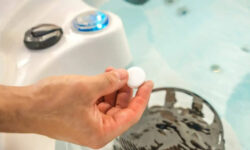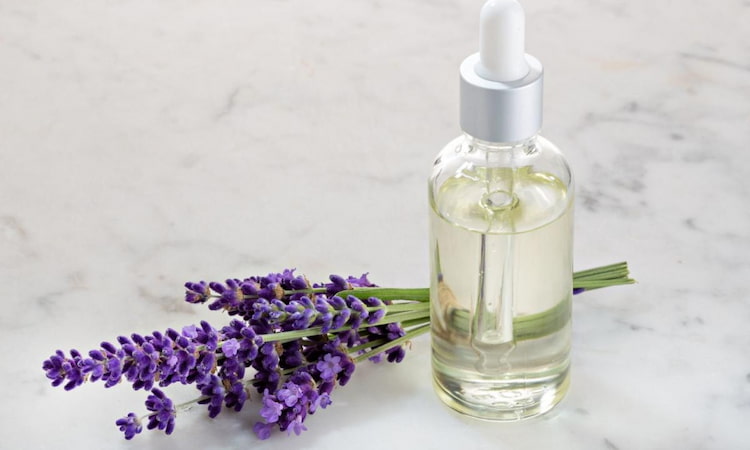You’re considering putting Epsom salt in your inflatable hot tub, aren’t you? Before you do, let’s explore what Epsom salt is, its effects on inflatable hot tubs, and the potential pros and cons. We’ll also delve into alternative options.
Yes, you can put Epsom salt in your inflatable hot tub. Epsom salt won’t damage your hot tub’s system, unlike regular table salt. It helps to soothe and relax your muscles and also increases the buoyancy in your tub. However, you should always make sure to follow the manufacturer’s instructions and not overuse it as it can lead to over-saturation and reduce the efficiency of your hot tub.
It’s important to make an informed decision to ensure you’re not damaging your tub or missing out on better solutions. So, sit back, relax, and let’s uncover the facts about using Epsom salt in your inflatable hot tub.
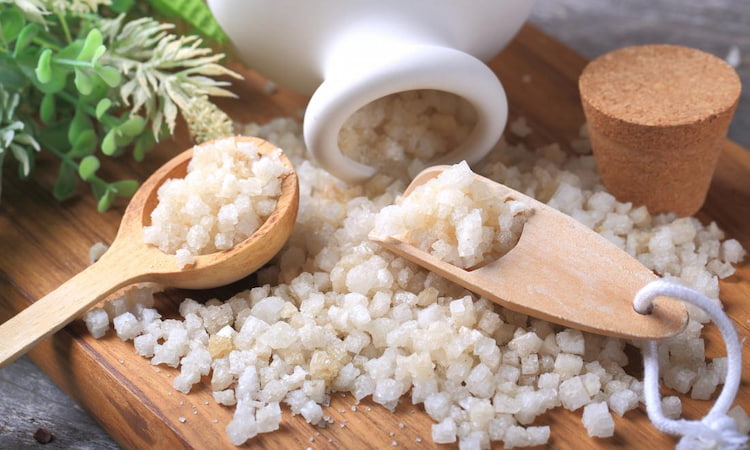
Quick Navigation
- The Composition and Uses of Epsom Salt
- Effects of Epsom Salt on Inflatable Hot Tubs
- Potential Advantages of Using Epsom Salt in Your Inflatable Hot Tub
- Possible Downsides and Risks of Adding Epsom Salt to Inflatable Hot Tubs
- Alternatives to Epsom Salt for Inflatable Hot Tubs
- Frequently Asked Questions
- Conclusion
The Composition and Uses of Epsom Salt
You’re probably wondering what Epsom salt is made of and why it’s commonly used in baths and spas. Well, Epsom salt, scientifically known as magnesium sulfate, is a mineral compound that’s rich in both magnesium and sulfate. It’s not actually salt, but a naturally occurring pure mineral compound.
This compound is renowned for its numerous health benefits. When dissolved in warm water, Epsom salt is easily absorbed through the skin where it can replenish the body’s magnesium levels. Magnesium is an essential mineral that aids in many bodily functions, including the regulation of enzymes and reduction of inflammation.
Epsom salt is commonly used in baths and spas because of its ability to soothe muscles, relieve pain, and reduce swelling. It also helps to exfoliate the skin and detoxify the body, promoting a feeling of relaxation and well-being.
Effects of Epsom Salt on Inflatable Hot Tubs
Before you go ahead and pour Epsom salt into your inflatable hot tub, it’s crucial to understand the potential effects it could have on the tub’s material and structure. Epsom salt, while beneficial to your skin and health, isn’t necessarily suitable for your inflatable hot tub.
Firstly, the granular nature of Epsom salt could potentially puncture or damage the liner. The tub’s material, usually PVC or vinyl, isn’t designed to withstand such abrasive substances. Over time, it could weaken the tub’s structure, leading to leaks or tears.
Secondly, Epsom salt can affect the water chemistry. It may increase the water’s hardness, making it more challenging to maintain proper pH and alkalinity levels. This may not only affect your bathing experience but also the lifespan of the tub.
Lastly, the salt can cause scale build-up on the heater and pump, hindering their performance and shortening their lifespan. Plus, the warranty may not cover such damages.
Potential Advantages of Using Epsom Salt in Your Inflatable Hot Tub
Despite the tub’s potential issues, let’s explore the benefits to your body that Epsom salt can provide when used in your inflatable hot tub. Epsom salt has been used for centuries for its health and beauty benefits. When you immerse yourself in a hot tub with Epsom salt, your skin absorbs the minerals, leading to numerous advantages.
Here are some of the potential benefits you may experience:
- Stress Reduction: Epsom salt baths can help to lower your stress levels. The magnesium in the salt promotes the production of serotonin, a mood-elevating chemical that creates a feeling of calm and relaxation.
- Pain and Cramp Relief: Soaking in Epsom salt can relieve body aches and muscle cramps. It’s beneficial for people with arthritis or muscle soreness after workouts.
- Improved Sleep and Concentration: Magnesium helps increase the production of melatonin, a hormone that promotes sleep. Additionally, it can enhance your brain’s neurotransmitters, improving your concentration.
- Skin Exfoliation: When used as a scrub, Epsom salt can exfoliate your skin, leaving it soft and glowing.
Combining the soothing warmth of a hot tub with Epsom salt’s benefits can turn your soak into a therapeutic experience.
Possible Downsides and Risks of Adding Epsom Salt to Inflatable Hot Tubs
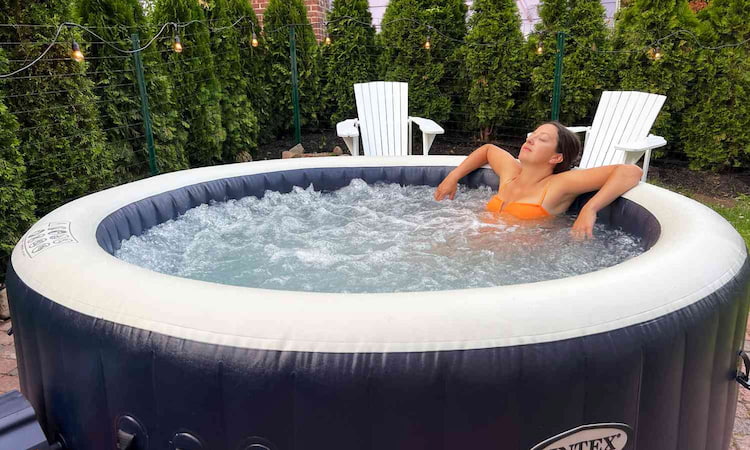
While your hot tub’s benefits might be tempting, it’s important to consider the potential downsides and risks of adding Epsom salt. First off, adding Epsom salt to an inflatable hot tub can potentially harm the tub’s structure. This is because the salt can cause the tub’s material to degrade and weaken over time.
Secondly, Epsom salt might interfere with your hot tub’s water chemistry. The salt could potentially raise the water’s hardness level, leading to scaling or mineral build-up, which can clog your hot tub’s filter and heating system. This could result in costly repairs or replacement parts.
Furthermore, if you’re thinking about using Epsom salt for its health benefits, it’s worth noting that the benefits may not be as significant as you’d hope. Some experts suggest that the beneficial effects of Epsom salt baths are more psychological than physical.
Lastly, if you do decide to add Epsom salt to your hot tub, you’ll have to drain and refill it more frequently. This not only means more work for you but also increased water usage. So, think twice before you pour that Epsom salt into your inflatable hot tub.
Alternatives to Epsom Salt for Inflatable Hot Tubs
Often, you’ll find that there are safer and equally effective alternatives to using Epsom salt in your inflatable hot tub. These options will not only ensure that your hot tub runs smoothly but also promote relaxation and therapeutic benefits.
Here’s a rundown of some options you might consider:
- Essential Oils: These are natural and offer a variety of health benefits. Lavender, for example, is known for its calming properties.
- Specially Formulated Spa Salts: These are designed to work with inflatable hot tubs and can enhance your soaking experience without causing any damage.
- Inflatable Hot Tub Chemicals: Chemicals such as bromine or chlorine can keep the water clean and safe for use.
- Aromatherapy Spa Products: These can help to create a relaxing atmosphere and can be especially beneficial if you’re using your inflatable hot tub to de-stress.
Frequently Asked Questions
You shouldn’t use Epsom salt in your inflatable hot tub. It can damage the tub’s materials and filtration system. Stick to chemicals designed specifically for inflatable hot tubs to maintain water quality and tub longevity.
You should add Epsom salt to your inflatable hot tub each time you change the water. It’s generally recommended to change the water every 3-4 weeks, so that’s when you’d add more Epsom salt.
Yes, you can combine Epsom salt with other treatments for your inflatable hot tub. However, you should check the manufacturer’s instructions to ensure it won’t harm your tub or interfere with other chemicals.
To store unused Epsom salt, keep it in an airtight container in a cool, dry place. Don’t expose it to moisture or heat. This will maintain its effectiveness for your future use.
Yes, you can use Epsom salt in your inflatable hot tub, even with specific health conditions. However, it’s important to consult your doctor first, as certain conditions may react negatively to the magnesium in the salt.
Conclusion
In short, adding Epsom salt to your inflatable hot tub isn’t usually recommended. While there may be potential benefits, the risks, including potential damage to your tub, often outweigh them.
It’s best to explore alternatives like scent-free spa chemicals or natural options. Always remember to check the manufacturer’s guidelines before adding anything to your tub to ensure its longevity.

![What is a Stabilizer in a Hot Tub? [Types of Stabilizers] what is a stabilizer in hot tubs and how does it work](https://hottubtales.com/wp-content/uploads/2023/10/what-is-a-stabilizer-in-hot-tubs-and-how-does-it-work-250x150.jpg)
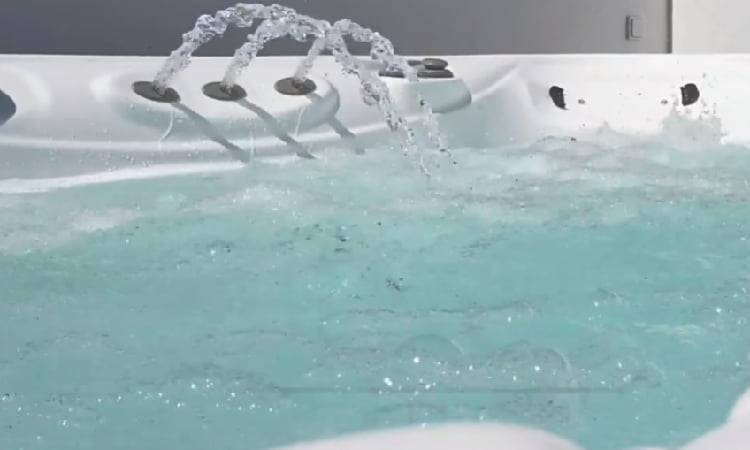
![Can You Over Shock a Hot Tub? [What to Do if You Did?] can you over shock a hot tub](https://hottubtales.com/wp-content/uploads/2023/10/can-you-over-shock-a-hot-tub-250x150.jpg)

